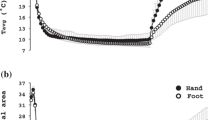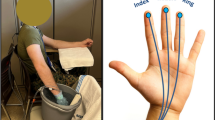Abstract
Cold-induced vasodilatation (CIVD) is proposed to be a protective response to preserve tissue integrity in the extremities during cold exposure, but little research exists on either the trainability or the spatial pattern of CIVD response in the foot. We investigated the thermal response across the foot with repeated cold exposure. Ten healthy subjects immersed their left foot to the ankle in 8°C water for 30 min 5 days/week for 3 weeks. Skin temperature was recorded on the medial side of the nail bed of the 5 toes and the dorsum of the foot. The presence of CIVD, defined as an increase of 1°C at any time during cooling, was rare with our protocol. While a CIVD response was observed at least once in 8 of the 10 subjects, only 122 instances of CIVD were observed out of a total of 900 possible observations (10 subjects × 6 sites × 15 trials). Furthermore, thermal habituation was not evident, with toe temperatures at the end of each immersion (8–11°C) remaining near water temperature throughout the 15 sessions. Even within the two subjects exhibiting the most incidence of CIVD, high variability existed in the occurrence, magnitude, and/or onset times. Synchronicity was often observed where more than one toe exhibited CIVD, though the magnitude varied greatly (range 1–9°C). We conclude that, under realistic conditions of whole-foot immersion in cold water, CIVD is not a common or trainable response.

Similar content being viewed by others
References
Adams T, Smith RE (1962) Effect of chronic local cold exposure on finger temperature responses. J Appl Physiol 17:317–322
Brajkovic D, Ducharme MB (2006) Facial cold-induced vasodilation and skin temperature during exposure to cold wind. Eur J Appl Physiol:1–11
Chen F, Liu ZY, Holmer I (1996) Hand and finger skin temperatures in convective and contact cold exposure. Eur J Appl Physiol Occup Physiol 72:372–379
Cheung SS, Mekjavic IB (2007) Cold-induced vasodilatation is not homogenous or generalizable across the hand and feet. Eur J Appl Physiol 99:701–705
Daanen HA (2003) Finger cold-induced vasodilation: a review. Eur J Appl Physiol 89:411–426
Daanen HA, van der Struijs NR (2005) Resistance Index of Frostbite as a predictor of cold injury in arctic operations. Aviat Space Environ Med 76:1119–1122
Ducharme MB, VanHelder WP, Radomski MW (1991) Cyclic intramuscular temperature fluctuations in the human forearm during cold-water immersion. Eur J Appl Physiol Occup Physiol 63:188–193
Geurts CL, Sleivert GG, Cheung SS (2005) Local cold acclimation of the hand impairs thermal responses of the finger without improving hand neuromuscular function. Acta Physiol Scand 183:117–124
Greenfield AD, Kernohan GA, Marshall RJ, Shepherd JT, Whelan RF (1951) Heat loss from toes and fore-feet during immersion in cold water. J Appl Physiol 4:37–45
Irving L, Andersen KL, Bolstad A, Elsner R, Hildes JA, Loyning Y, Nelms JD, Peyton LJ, Whaley RD (1960) Metabolism and temperature of Arctic Indian men during a cold night. J Appl Physiol 15:635–644
Krog J, Folkow B, Fox RH, Andersen KL (1960) Hand circulation in the cold of Lapps and North Norwegian fisherman. J Appl Physiol 15:654–658
Leblanc J (1962) Local adaptation to cold of Gaspe fishermen. J Appl Physiol 17:950–952
Leblanc J, Hildes JA, Heroux O (1960) Tolerance of Gaspe fishermen to cold water. J Appl Physiol 15:1031–1034
Lewis T (1930) Observations upon the reactions of the vessels of the human skin to cold. Heart 15:177–208
Livingstone SD (1976) Changes in cold-induced vasodilation during Arctic exercises. J Appl Physiol 40:455–457
Miller LK, Irving L (1962) Local reactions to air cooling in an Eskimo population. J Appl Physiol 17:449–455
Nelms JD, Soper DJ (1962) Cold vasodilatation and cold acclimatization in the hands of British fish filleters. J Appl Physiol 17:444–448
O’Brien C (2005) Reproducibility of the cold-induced vasodilation response in the human finger. J Appl Physiol 98:1334–1340
Purkayastha SS, Selvamurthy W, Ilavazhagan G (1992) Peripheral vascular response to local cold stress of tropical men during sojourn in the Arctic cold region. Jpn J Physiol 42:877–889
Acknowledgments
The authors wish to express their gratitude to the subjects for their participation. This research was funded by a Discovery Grant (S.S. Cheung and G.G. Sleivert) from the Natural Sciences and Engineering Research Council (NSERC) of Canada.
Author information
Authors and Affiliations
Corresponding author
Rights and permissions
About this article
Cite this article
Reynolds, L.F., Mekjavic, I.B. & Cheung, S.S. Cold-induced vasodilatation in the foot is not homogenous or trainable over repeated cold exposure. Eur J Appl Physiol 102, 73–78 (2007). https://doi.org/10.1007/s00421-007-0566-9
Accepted:
Published:
Issue Date:
DOI: https://doi.org/10.1007/s00421-007-0566-9




